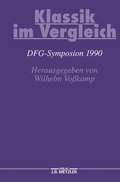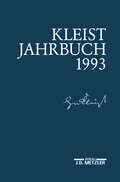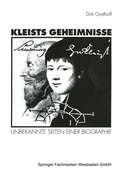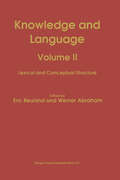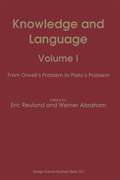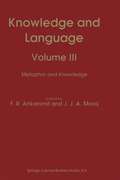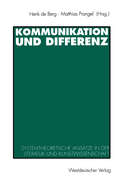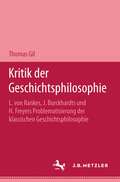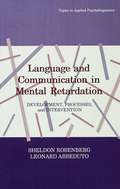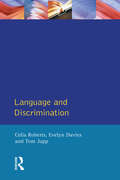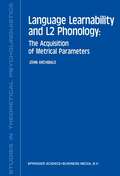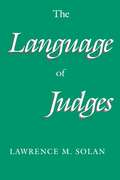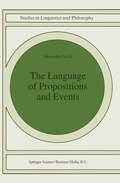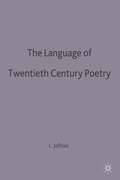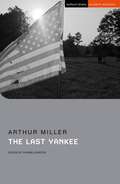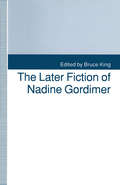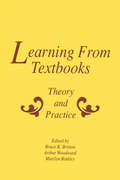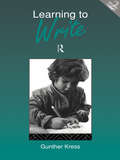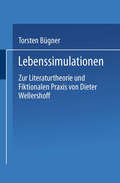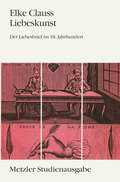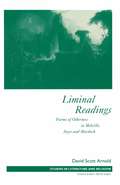- Table View
- List View
Klassik im Vergleich: DFG-Symposion 1990 (Germanistische Symposien)
Das Klassik-Problem muss stets in seiner Doppelheit von Normativität und Historizität gesehen werden. Erst im Spannungsverhältnis beider Aspekte entsteht der literaturwissenschaftliche Gegenstand Klassik, der in diesem Band anhand verschiedener europäischer Klassiken diskutiert wird.
Kleists Geheimnisse: Unbekannte Seiten einer Biographie
by Dirk GrathoffDas Buch von Dirk Grathoff schlägt eine neue Lösung für das Rätsel der Würzburger Reise Heinrich von Kleists aus dem Jahre 1800 vor, dem die Forschung bislang vergebens nachspürte. Weder eine Geschlechtsoperation noch Industriespionage waren der Anlaß für die Reise, wie ältere Spekulationen mutmaßten, sondern Bemühungen, mit Freimaurern außerhalb Preußens in Kontakt zu kommen, um von ihnen eine mäzenatenartige Unterstützung für seine geplante philosophische Ausbildung zu erhalten. Mit diesem Anliegen ist Kleist in Würzburg offensichtlich gescheitert, doch die Kontakte, die er dort knüpfen konnte, waren hochkarätig: Er traf mit Christoph Wilhelm Hufeland, dem Jenaer Mediziner und späteren Direktor der Berliner Charité, und mit Gustav Graf von Schlabrendorf zusammen. Die Begegnung mit dem schlesischen Grafen von Schlabrendorf, der seit 1789 im Pariser Exil lebte, eröffnet neuartige Perspektiven für Kleists antinapoleonische Einstellung, die schon frühzeitig während seiner Besuche in Paris durch girondistische Schriften von Schlabrendorfs beeinflußt worden ist. Insgesamt wird mit dem Buch Kleists Entwicklung zum Schriftsteller in einer bisher noch nicht bekannten Sicht vorgestellt.
Knowledge and Language: Volume II Lexical and Conceptual Structure
by E. Reuland W. Abraham1. BACKGROUND This volume is one of three which emerged from the Conference on Knowledge and Language, held from May 21-May 25, 1989, at the occasion of the 37 5th anniversary of the University of Groningen. Studying the relation between knowledge and language, one may distinguish two different lines of inquiry, one focussing on language as a body of knowledge, the other on language as a vehicle of knowledge. Approaching language as a body of knowledge one faces questions concerning its structure, and the relation with other types of knowledge. One will ask, then, how language is acquired and to what extent the acquisition of language and the structure of the language faculty model relevant aspects of other cognitive capacities. If language is approached as a vehicle for knowledge, the question comes up what enables linguistic entities to represent facts about the world. To what extent does this reply on conventional aspects of mean ings? Is it possible for language, when used non-conventionally as in metaphors, to convey intersubjective knowledge? If so (and it does seem to be the case), one may wonder what makes this possible. The aim of this conference was to investigate the role of conceptual structure in cognitive processes, exploring it from the perspectives of philosophy of language, linguistics, political philosophy, psychology, liter ary theory, aesthetics, and philosophy of science. The themes of these three volumes reflect the themes of the conference.
Knowledge and Language: Volume I From Orwell’s Problem to Plato’s Problem
by E. Reuland W. Abraham1. BACKGROUND This volume is one of three which emerged from the Conference on Knowledge and Language, held from May 21-May 25, 1989, at the occasion of the 37 5th anniversary of the University of Groningen. Studying the relation between knowledge and language, one may distin guish two different lines of inquiry, one focussing on language as a body of knowledge, the other on language as a vehicle of knowledge. Approaching language as a body of knowledge one faces questions concerning its structure, and the relation with other types of knowledge. One will ask, then, how language is acquired and to what extent the acquisition of language and the structure of the language faculty model relevant aspects of other cognitive capacities. If language is approached as a vehicle for knowledge, the question comes up what enables linguistic entities to represent facts about the world. To what extent does this rely on conventional aspects of meaning? Is it possible for language, when used non-conventionally as in metaphors, to convey intersubjective knowledge? If so (and it does seem to be the case), one may wonder what makes this possible. The aim of this conference was to investigate the role of conceptual structure in cognitive processes, exploring it from the perspectives of philosophy of language, linguistics, political philosophy, psychology, liter ary theory, aesthetics, and the philosophy of science. The themes of these three volumes reflect the themes of the conference.
Knowledge and Language: Volume III Metaphor and Knowledge
by F. R. Ankersmit J. J. A. MooijMetaphor lies at the heart of the contemporary debate in aesthetics, semantics and the philosophy of science. It is generally recognised now that metaphor is not an obfuscation of the truth (as so many philosophers since Plato have argued); on the contrary, it is essential that we consider metaphor if we strive for an optimal understanding of how truth is gained both in science and in our everyday dealings with reality. Hence, metaphor is not of interest only for the literary theorists, but for all those who wish to understand science and how to grasp the structure of our social world. This volume presents eleven essays on the role of metaphor in philosophy, poetry, semiotics, art, literary criticism, economics, medical science and in political theory. Through the use of metaphor, the contributors provide a unique and exciting picture of these disciplines.
Kommunikation und Differenz: Systemtheoretische Ansätze in der Literatur- und Kunstwissenschaft
by Henk De Berg Matthias PrangelDie primär soziologische (Luhmannsche) Systemtheorie beginnt seit einiger Zeit auch in die Disziplinen der Literaturwissenschaft, Kunstwissenschaft und Musikwissenschaft auszustrahlen. In diesem Band werden die Konsequenzen in zwölf Beiträgen erstmals auf interdisziplinärer Ebene thematisiert. Dabei geht es nicht darum, die Profilierung nur einer einzigen Adaptionsweise der Systemtheorie zu betreiben, sondern ganz unterschiedliche Tendenzen systemtheoretisch inspirierten Arbeitens in den Geisteswissenschaften zu beleuchten.
Kritik der Geschichtsphilosophie: L. von Rankes, J. Burckhardts und H. Freyers Problematisierung der klassischen Geschichtsphilosophie. M&P Schriftenreihe
by Thomas GilLanguage and Communication in Mental Retardation: Development, Processes, and intervention (Topics in Applied Psycholinguistics Series)
by Sheldon Rosenberg Leonard AbbedutoResearch on language and communication development and intervention in persons with mental retardation has been conducted at a fast and furious pace during the last two decades. Past attempts to summarize this research have been rather restricted, focusing on a single, narrowly defined substantive domain such as lexical development, or of a single etiology such as Down Syndrome. This volume, in contrast, presents a critical, integrative review of research and theory on language development and processing across all domains and a variety of etiologies. In addition, many previous attempts to review portions of this research have failed to consider the research within the context of current theory and data from developmental psycholinguistics and linguistics. A major contribution of this book is the emphasis on relevant work outside of mental retardation for understanding and treating the language and communication problems of persons with mental retardation. Finally, this book is comprehensive and up-to-date across all the areas of language covered including appropriate introductory material in linguistics and psychology -- discussions of the innateness, cognition-first and motherese views of normal language acquisition. In addition, the authors' extensive bibliography is valuable in and of itself to any serious student or professional in the area.
Language and Communication in Mental Retardation: Development, Processes, and intervention (Topics in Applied Psycholinguistics Series #Volume 27)
by Sheldon Rosenberg Leonard AbbedutoResearch on language and communication development and intervention in persons with mental retardation has been conducted at a fast and furious pace during the last two decades. Past attempts to summarize this research have been rather restricted, focusing on a single, narrowly defined substantive domain such as lexical development, or of a single etiology such as Down Syndrome. This volume, in contrast, presents a critical, integrative review of research and theory on language development and processing across all domains and a variety of etiologies. In addition, many previous attempts to review portions of this research have failed to consider the research within the context of current theory and data from developmental psycholinguistics and linguistics. A major contribution of this book is the emphasis on relevant work outside of mental retardation for understanding and treating the language and communication problems of persons with mental retardation. Finally, this book is comprehensive and up-to-date across all the areas of language covered including appropriate introductory material in linguistics and psychology -- discussions of the innateness, cognition-first and motherese views of normal language acquisition. In addition, the authors' extensive bibliography is valuable in and of itself to any serious student or professional in the area.
Language and Discrimination
by Celia Roberts Evelyn Davies Tom JuppLangauge and Discrimination provides a unique and authoritative study of the linguistic dimension of racial discrimination. Based upon extensive work carried out over many years by the Industrial Language Training Service in the U.K, this illuminating analysis argues that a real understanding of how language functions as a means of indirect racial discrimination must be founded on an expanded view of language which recognises the inseparability of language, culture and meaning.After initially introducing the subject matter of the book and providing an overview of discrimination and language learning, the authors examine the relationship between theory and practice in four main areas: theories of interaction and their application; ethnographic and linguistic analysis of workplace settings; training in communication for white professionals; and language training for adult bilingual workers and job-seekers. Detailed case studies illustrate how theory can be turned into practice if appropriate information, research, development and training and co-ordinated in an integrated response to issues of multi-ethnic communication, discrimination and social justice.
Language and Discrimination
by Celia Roberts Evelyn Davies Tom JuppLangauge and Discrimination provides a unique and authoritative study of the linguistic dimension of racial discrimination. Based upon extensive work carried out over many years by the Industrial Language Training Service in the U.K, this illuminating analysis argues that a real understanding of how language functions as a means of indirect racial discrimination must be founded on an expanded view of language which recognises the inseparability of language, culture and meaning.After initially introducing the subject matter of the book and providing an overview of discrimination and language learning, the authors examine the relationship between theory and practice in four main areas: theories of interaction and their application; ethnographic and linguistic analysis of workplace settings; training in communication for white professionals; and language training for adult bilingual workers and job-seekers. Detailed case studies illustrate how theory can be turned into practice if appropriate information, research, development and training and co-ordinated in an integrated response to issues of multi-ethnic communication, discrimination and social justice.
Language Learnability and L2 Phonology: The Acquisition of Metrical Parameters (Studies in Theoretical Psycholinguistics #19)
by J. ArchibaldIn this book Archibald describes two studies conducted within a parametric framework in the area of second language acquisition. The studies are designed to investigate the acquisition of English stress patterns (via both production and perception tasks) by adult speakers of Polish and Hungarian. Archibald argues that interlanguage grammars can be understood as a mix of L1 transfer and the effects of Universal Grammar. Metrical parameters related to such things as quantity--sensitivity, extrametricality, and word--tree dominance determine the structure of the interlanguage. The author reports that the subjects are remarkably successful at acquiring English stress and do not appear to violate proposed universals of metrical phonology. This book is one of the few attempts to investigate the acquisition of L2 phonology within a UG framework. Empirical support is provided for the parametric model to an extent uncommon in most syntactic studies.
The Language of Judges (Chicago Series in Law and Society)
by Lawrence M. SolanSince many legal disputes are battles over the meaning of a statute, contract, testimony, or the Constitution, judges must interpret language in order to decide why one proposed meaning overrides another. And in making their decisions about meaning appear authoritative and fair, judges often write about the nature of linguistic interpretation. In the first book to examine the linguistic analysis of law, Lawrence M. Solan shows that judges sometimes inaccurately portray the way we use language, creating inconsistencies in their decisions and threatening the fairness of the judicial system. Solan uses a wealth of examples to illustrate the way linguistics enters the process of judicial decision making: a death penalty case that the Supreme Court decided by analyzing the use of adjectives in a jury instruction; criminal cases whose outcomes depend on the Supreme Court's analysis of the relationship between adverbs and prepositional phrases; and cases focused on the meaning of certain words in the Constitution. Solan finds that judges often describe our use of language poorly because there is no clear relationship between the principles of linguistics and the jurisprudential goals that the judge wishes to promote. A major contribution to the growing interdisciplinary scholarship on law and its social and cultural context, Solan's lucid, engaging book is equally accessible to linguists, lawyers, philosophers, anthropologists, literary theorists, and political scientists.
The Language of Propositions and Events: Issues in the Syntax and the Semantics of Nominalization (Studies in Linguistics and Philosophy #51)
by Alessandro ZucchiAt a superficial examination, English has different types of nominals with similar meaning and distribution: (1)a. John's performance ofthe song b. J ohn' s performing of the song c. John's performing the song d. the fact that John performs the song These nominals are also perceived by English speakers to be related to the same sentential construction: (2) John performs the song A more accurate inspection reveals, however, that the nominals in (1) differ both in their distribution and in the range of interpretations they allow. An adequate theory of nominalization should explicate rigorously how nominals of the types in (1) are related to sentential construction (2), and should also account for their distributional differences and meaning differences. The task of this book is to develop such a theory. I defend two main theses. The first is that, in order to provide an adequate semantics for the nominals in (1), one needs to distinguish among three types of entities in the domain of discourse (in addition to the type of ordinary individuals): events, propositions, and states xiii XIV PREFACE of affairs. I argue that the nominals in (1) differ in their ability to denote entities of these types and that predicates differ in their ability to select for them.
The Language of Twentieth Century Poetry
by Lesley HeffriesThis book draws on examples from throughout the twentieth century to illustrate the diversity of techniques used in this century's poetry. Organised according to linguistic themes, rather than chronologically, the chapters introduce the reader to the more subtle uses of sound, structure and meaning as well as illustrating well-known techniques handed-down from the poetic tradition. Examples are taken from the famous writers of the twentieth century, such as Yeats, Eliot and Plath and from less well-known poets. The book culminates in a chapter which draws together the linguistic themes into an integrated analysis of two rather different poems.
The Last Yankee (Student Editions)
by Arthur Miller'When the play focuses on the self-entrapment of the characters, Mr. Miller can be tender as well as trenchant' NEW YORK TIMES Two strangers meet in a New England psychiatric clinic, each visiting their admitted, depressed wife: one is a humble carpenter with seven children, the other a successful businessman in a childless marriage; both have been forgotten by the promise of the American Dream.Described by Miller as 'a comedy about a tragedy', this one-act play highlights the devastating consequences for those who fail to achieve the purported riches of the American Dream; a reality many face.This Methuen Drama Student Edition is edited by Ciarán Leinster, with commentary and notes that explore the play's production history (including excerpts from an interview with director David Thacker) as well as the dramatic, thematic and academic debates that surround it.
The Later Fiction of Nadine Gordimer
by Bruce KingNobel Prizewinner Nadine Gordimer's novels and short stories from The Conservationist to Jump have been her best and most controversial work. This new book examine such topics as the autobiographical basis of her fiction, her relationship to feminism, the place of the white woman in black Africa, the ambiguity of revolutionary politics, her ambivalent relationship to Judaism, her use of irony, the symbolism of landscape, and the ways in which she has revised recurring topics throughout her career as a writer.
Learning From Textbooks: Theory and Practice
by Arthur Woodward Marilyn Binkley Bruce K. BrittonIt is surprising that there is so little research on textbooks, given their centrality to teaching and learning in elementary and secondary schools. Textbooks have become a focus of political and cultural controversy, advocating a multicultural curriculum that has sparked some vigorous protests. Research is absent in this debate; therefore, questions of legitimate knowledge, the role of textbooks, textbook design, policy selection issues, and economic issues concerning the marketplace are not part of the current debate. Without insights of research on considerate text, mentioning, illustrations and so forth, the current controversy will result in publishers responding to demands for more content not less; thus, textbooks will become compendia of information that on the surface satisfy everyone. This volume demonstrates how research on important issues relative to textbook design can advance our knowledge about what makes textbooks effective learning tools, and thus inform policymakers, publishers, and those involved in textbook selection. Representing pure and applied approaches, researchers present papers on the quality of writing, the role of questions, the role of pictures and illustrations, and the role of auxiliary materials in the design of effective textbooks. The chapters provide insight into research and its application to textbook design and improvement -- stimulating others to follow this lead.
Learning From Textbooks: Theory and Practice
by Bruce K. Britton Arthur Woodward Marilyn BinkleyIt is surprising that there is so little research on textbooks, given their centrality to teaching and learning in elementary and secondary schools. Textbooks have become a focus of political and cultural controversy, advocating a multicultural curriculum that has sparked some vigorous protests. Research is absent in this debate; therefore, questions of legitimate knowledge, the role of textbooks, textbook design, policy selection issues, and economic issues concerning the marketplace are not part of the current debate. Without insights of research on considerate text, mentioning, illustrations and so forth, the current controversy will result in publishers responding to demands for more content not less; thus, textbooks will become compendia of information that on the surface satisfy everyone. This volume demonstrates how research on important issues relative to textbook design can advance our knowledge about what makes textbooks effective learning tools, and thus inform policymakers, publishers, and those involved in textbook selection. Representing pure and applied approaches, researchers present papers on the quality of writing, the role of questions, the role of pictures and illustrations, and the role of auxiliary materials in the design of effective textbooks. The chapters provide insight into research and its application to textbook design and improvement -- stimulating others to follow this lead.
Learning to Write
by Gunther KressFirst published in 1982, this influential and classic text poses two questions: what is it that a child learns when he or she learns to write? What can we learn about children, society and ourselves, by looking at this process? The book is based on a close analysis of a series of written texts by primary school children and is written for student teachers with little or no knowledge of linguistics. In this new edition, Gunther Kress has made extensive revisions in the light of recent developments in linguistics and in education. The theoretical focus is now a social semiotic one, which allows a fundamental rethinking of issues such as 'preliteracy' and broad social and cultural questions around the making of texts.
Learning to Write
by Gunther KressFirst published in 1982, this influential and classic text poses two questions: what is it that a child learns when he or she learns to write? What can we learn about children, society and ourselves, by looking at this process? The book is based on a close analysis of a series of written texts by primary school children and is written for student teachers with little or no knowledge of linguistics. In this new edition, Gunther Kress has made extensive revisions in the light of recent developments in linguistics and in education. The theoretical focus is now a social semiotic one, which allows a fundamental rethinking of issues such as 'preliteracy' and broad social and cultural questions around the making of texts.
Lebenssimulationen: Zur Literaturtheorie und Fiktionalen Praxis von Dieter Wellershoff
by Torsten BügnerLiebeskunst: Der Liebesbrief im 18. Jahrhundert. Metzler Studienausgabe
by Elke ClaussMit der Freisetzung von Individualität im 18. Jahrhundert verlangt die neu definierte Privatsphäre nach einem ihr gemäßen Ausdruck. Sie findet für die am höchsten individualisierte Form zwischenmenschlicher Beziehung - die Liebe - das Korrespondenzmittel des Liebesbriefs.
